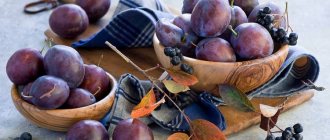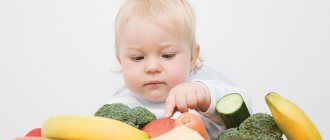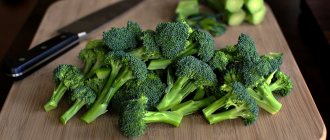One of the important products necessary for feeding infants is low-fat sea and river fish, which contains fish oil, amino acids, vitamins F, A, D, E, B-12, which are very beneficial for the body, and minerals that promote proper metabolism: iodine , manganese, zinc, copper, boron, iron, fluorine, etc.
The choice of fish for a child's diet should be taken very seriously: if possible, use fresh fish; when buying whole fish, you should pay attention to the scales (high-quality fish have shiny ones), gills (without mucus), when buying fillets - to the color (white or pale -pink). Sea fish is safe and very healthy, as it is rich in minerals (primarily iodine and fluorine), as well as omega-3 fats; but it can usually only be bought frozen. Of river fish, which is more accessible and easier to digest by the body, nutritionists give preference to trout (it lives only in clean water and, therefore, does not contain harmful substances) and fish grown in artificial reservoirs.
Introducing fish into a baby's diet
When to introduce fish to an infant
Fish is introduced into the diet of infants later than other foods, as it can cause allergies. Nutritionists advise giving your child fish only after he has become accustomed to eating meat - at 9-10 months. You need to introduce fish into your baby’s menu gradually: start with 5-10 grams per day and increase the daily intake to 70 grams by 12 months. It must be remembered that fish broth contains substances that are harmful to the child’s body and are released during the cooking process, so fish soups are recommended to be given to children from 1.5-3 years old. You should also not feed infants fried, smoked, salted fish or fatty fish (all salmon, sturgeon, herring).
In order not to overload the child’s digestive system, you should alternate fish and meat days during the week, avoiding preparing these dishes on the same day; cook fish dishes no more than 2 times a week.
If eating fish has caused an allergy in a child, you should exclude it from the diet for two weeks, then try to cook a different type of fish (an allergy to both all fish and a specific type is possible).
Fish for children under one year old
Fish is a valuable protein product that contains all the amino acids necessary for a child’s body, a unique vitamin complex (F, A, D, E) in combination with healthy fish oil and minerals important for healthy metabolism (iodine, manganese, zinc, copper, boron, iron, fluorine, etc.).
For children under one year old, low-fat fish varieties are suitable - hake, cod, pike perch, pollock, grenadier, blue whiting, pike, mullet, catfish, herring, etc.
When can you start giving your child fish?
According to the recommendations of nutritionists, fish can be introduced into a child’s menu no earlier than 9-10 months. This should be done only after the baby has completely mastered meat products. Remember that fish is a strong allergen, so it must be consumed with extreme caution. You should start feeding with 5-10 grams per day. Observing the reaction of the baby’s body, gradually increase the dose. The maximum daily intake of fish for a one-year-old child is 70 grams. It is recommended to give it to a healthy child no more than 2 times a week. Distribute “fish” and “meat” days, since taking two of these products at once during the day will create a large load on the baby’s digestive system. Giving fish broth to children under 3 years of age is generally not recommended, due to its low nutritional value and the content of harmful substances released during the cooking process.
As a rule, a child can be allergic to all fish, without exception, or to certain types of fish. At the first signs of diathesis in a child, you need to take a two-week break, completely eliminating fish dishes from the diet. After the allergy symptoms subside, try reintroducing some other type of fish into the menu. Do this the same way as the first time, gradually, starting with 5-10 grams per day. Even in the absence of an allergic reaction, do not exceed the recommended daily intake.
How to cook fish for a child?
- You need to defrost fish in salted water.
- It is very important to carefully cut and remove all bones, even if you buy ready-made fillets.
- The fish should be steamed or boiled in a small amount of water.
- Boil the fish for 10-15 minutes if the pieces are small and 20-25 minutes if the fish is cooked whole.
Simple and healthy recipes for fish dishes for children under one year old
- Fish puree.
Cook lean fish fillet (100 g) until tender and grind in a blender. Add milk (1 tsp) and vegetable oil (1 tsp) and mix. Boil the resulting mass for a couple more minutes. - Fish pudding.
From boiled potatoes (1 pc.), milk (2-3 tbsp.) - Fish meatballs.
Grind fish fillet (60 g) and soaked white bread (10 g) through a meat grinder 2-3 times, add egg yolk (1/4 pcs.), salt, vegetable oil (1 tsp) and mix well. We form small balls from the resulting mass, fill them with water (up to half) and simmer for about 30 minutes. over low heat.
and vegetable oil (2 tsp) make puree. Add the prepared fish fillet (100 g), having previously chopped it, and an egg beaten with salt (½ pcs.). Mix everything and put it in the mold. Cook in steam or water bath for 30 minutes.
After a year, the child can be offered a more varied menu of fish dishes.
How to cook fish for babies
Until a child is one year old, it is preferable to cook exclusively white fish, at least until 10 months.
If you are boiling fish, then after freezing it and rinsing it in cold water, immediately place it in boiling water, remembering to reduce the gas to minimum.
How to cook fish for babies
When preparing fish for infants, several rules must be followed:
- defrost the fish in salted water (this will prevent bacteria from forming on it), and immediately begin heat treatment;
- Before cooking, rinse the fish well;
- be sure to check the fillet for bones;
- cook fish in two ways: in a double boiler or boiling in a large amount of water (cooking time for small pieces - 10-15 minutes, for whole fish - 20-25 minutes).
How long to cook fish
Different types of fish are cooked differently. The fastest to cook is red fish - salmon, salmon or pink salmon; steaks 3-4 cm thick are cooked for about 8-10 minutes. White fish, which has a denser structure, takes a little longer to cook - after boiling, 10-12 minutes.
In order not to overcook the fish, you should cook it only over low heat, but so that the fish boils. If you need to cook boiled fish with vegetables, be guided by the cooking time of the vegetables, since fish will cook longer at a lower temperature. Vegetables with boiled fish are an excellent basis for a diet dinner, and simply an irreplaceable dish.
There are many options for cooking fish. It can be fried, stewed, steamed... Today we will talk about how to properly cook fish. For cooking, they use such types of fish as flounder, hake, trout, halibut, carp and many others.
Fish recipe for babies
Fish puree for babies
It is better to introduce fish into a baby’s diet in the form of puree. To prepare it, you need to boil 100 g of lean fish: hake, pollock, cod, haddock, flounder - and grind in a blender. Add 1 tsp to the fish. milk and vegetable oil. Mix the resulting mass well and boil for 2 minutes.
To the fish puree, especially during the first feedings, you can add a little ready-made potato or vegetable puree, to which the child is already accustomed.
Fish pudding
Boil the fillet, chop, then mix well with half an egg beaten with salt and mashed potatoes (ingredients: 1 potato, 2-3 tbsp milk, 2 tsp vegetable oil). Transfer the resulting mass into a mold and steam or steam for half an hour.
Seasonings for cooking fish
If you are cooking fish that has a delicate, unsaturated taste, then use a minimum of seasonings. It is best to use only salt and white roots. Cook fish that has a rich taste, such as carp, silver carp, with the addition of bay leaves, carrots, and onions. Add some pepper. The fish will be spicy and tasty. If the fish has an unpleasant odor, then cucumber pickle will help neutralize it. Add it to the broth when cooking and you will improve the taste of the dish.
Cooked fish can wait about 30 minutes before serving in the broth. But you shouldn't keep it there longer. If you want to save the fish until the next meal, then add a little broth to the container where it will be stored (maybe in the same pan in which it was cooked). It will remain juicy.
If you use broth to make sauces, add as little salt as possible. The broth will become transparent if it is passed through several layers of damp gauze several times. Whipped egg white will help make it lighter. Steaming fish will make it even more tasty and healthy. A small amount of cucumber brine will improve the taste of the fish.
Fish is an indispensable product on our tables, rich in protein and Omega-3 acids. There are several ways to cook fish - boiling, stewing, baking, frying in oil or batter, cooking over charcoal. But the most useful, especially for those who adhere to a diet, will not be fried fish, but boiled fish. A recipe can be found to suit every taste, using sea or river fish. This dish will undoubtedly be healthy and low in calories. In this regard, housewives very often have questions about how to properly cook fish in order to preserve its taste and healthy qualities as much as possible.
Fish casserole
Boil the gutted and cleaned fish in boiling water (5 minutes), cool quickly in cold water, place on a sieve and let the water drain. Cut into pieces and remove the flesh from the bones. Place the pieces of fish in a fireproof clay cup, greased with oil, pour over the bechamel sauce, sprinkle with grated cheese and sifted breadcrumbs on top. Bake in the oven for 15-20 minutes.
Compound:
- fish - 100 g,
- butter - 1 teaspoon,
- cheese - 10 g,
- breadcrumbs - 7 teaspoon,
- salt,
- sauce.
How to cook fillet
There are several simple ways to cook hake. The fish turns out tasty and very healthy. The taste characteristics of the dish directly depend not only on the quality of the carcass itself, but also on how long to cook the hake. Let's look at several options for how to cook hake fish at home.
Option 1: cooking in a pan
Pour water into a suitable sized saucepan. There is no need to fill the container completely; the water should cover the fish fillets. Next, the contents need to be salted and brought to a boil. After boiling, add bay leaves, a few peppercorns and boil over medium gas until a spicy aroma begins to emanate from the water. This process takes no more than 7 minutes. At the next stage, immerse the fish fillet in the spicy liquid, cover the pan with a lid and boil for half an hour.
Option 2 – in a double boiler
With this method, fillet pieces need to be laid out on the bottom of a special container with holes and salted. You can also add bay leaves and pepper to add flavor to the dish. Cook the fillet in a double boiler for about 40 minutes.
Option 3 – in a slow cooker
To make the process of cooking hake take less time, you can use a slow cooker. Along with the fish, add salt, a couple of bay leaves and a few peas of allspice to the water. To cook the fish, you need to cook it for 25 minutes. There is another option for cooking hake in a multicooker - cooking in the “Steam” mode. To do this, you will need to first defrost the carcass if you are using frozen fish. Then gut it, wash it and cut it into portions. Salt the fish steaks, season with spices and leave for 15 minutes, giving them a little time to “rest”. Next, the hake pieces must be transferred to a special sieve for steaming, which is placed on a bowl of water. Close the lid tightly and let the fish steam until cooked for 25 minutes. With this method of cooking, almost all vitamins and nutrients are preserved in the hake.
The finished pieces of fish acquire a denser structure, and their color becomes uniform white. The cooked fillet is transferred to a dish. Before serving, it is recommended to sprinkle the slices with lemon juice.
Fresh vegetables, herbs or boiled rice are suitable as a side dish.
What types of fish can children eat?
Start complementary feeding with low-fat varieties of fish, it is worth starting with silver carp, cod or pollock. Also suitable: hake, flounder, pollock and sea bream. Their meat contains only 4% fat and they are less allergenic. At 1.5 years old, you can introduce your baby to carp, pink salmon, perch and catfish. They are considered a fish with moderate fat content (only 8%). Fish broth should also be given to a child after one year. and only from the age of three can you start giving your baby fatty varieties of fish - mackerel, salmon, salmon and sturgeon. Regarding the issue of seafood, they should be introduced into a child’s diet no earlier than three years of age due to their high allergenicity.
What kind of fish should I give my child?
Choose only high-quality and fresh fish. It's good if it's freshly caught. Otherwise, you can buy a frozen product. But it is important that the carcass is not defrosted earlier. It should be smooth and without icing on the sides. After defrosting, the meat of high-quality fish is dense and difficult to separate from the bones. If it becomes dark or dull or has an unpleasant odor, it means that the fish has been frozen and thawed several times.
Live fish must have intact scales and a well-fed carcass, with gills that move evenly. A healthy fish will have a fleshy and non-pointy back. High-quality chilled fish has a dense structure, bulging and transparent eyes, and bright red gills. The carcass should be free of spots and bruises, with even, smooth and shiny scales.
The benefits of fish dishes for children
If the child is not allergic, fish dishes should be introduced into the diet starting from 8 - 9 months, since this protein is absorbed much better than meat. Compare: 96 - 98% to 87 - 89%, that is, proteins obtained from fish not only enter the baby’s body, but do so in the most “targeted” way.
With its help, it will be easier for a child to build bones, muscles, and form tooth enamel. Fish has everything necessary for this: fluorine, phosphorus, iron, amino acids, B vitamins, which are no less than in beef. And, most importantly, if we are talking about marine, we will find iodine, necessary for mental development, and polyunsaturated fatty acids Omega-3 and Omega-6, which improve concentration and memory.
If the child is allergic
So, the question of the benefits of fish and its need for children’s diets is no longer relevant, is it? But what to do if your child is allergic?
It is enough to postpone its introduction into complementary foods until 12 - 18 months and prepare only white varieties, avoiding any red types of meat. Of course, we are talking about boiled and stewed dishes; Baked, and even more so fried fish can be offered to children only from the age of 2.
Useful properties of fish for children
Fish is especially beneficial due to its high content of easily digestible protein. It is necessary for the full development of the body and the formation of new cells. Fish protein contains amino acids that are not produced by the human body independently and can only enter it from the outside (with food).
Another valuable component of this product is fish oil. It is rich in polyunsaturated fatty acids, which are necessary for the development of the child’s brain and strengthening his brain activity. It also has a beneficial effect on the cardiovascular and excretory systems; it is recommended to use it to increase immunity and protect against viral infections during seasonal epidemics.
Fish contains large amounts of vitamin D, which is involved in the formation of bone tissue and teeth. For young children, it is recommended to give this vitamin additionally in the form of pharmaceutical drops if the baby’s diet does not contain fish. Vitamin B12, also found in fish products, has the function of hematopoiesis and has a positive effect on the baby’s nervous system.
In dietetics, fish is valued not so much for its vitamin complex, but for its rich mineral composition:
- iodine (affects the functioning of the thyroid gland)
- selenium (ensures the formation of immunity)
- calcium (affects the formation of the child’s teeth)
- copper (takes part in hemoglobin synthesis)
- manganese (ensures normal skeletal development, good growth)
- phosphorus (helps cope with dizziness)
- iron (increases hemoglobin levels, accelerates growth, strengthens immunity)
- magnesium (participates in protein synthesis)
For young children, fish (which type we will discuss later) is useful because due to its delicate texture (without hard fibers, like in meat), it is easier to break down under the influence of gastric juices and is better absorbed (up to 98%).











